As an Amazon Associate KitchenwareSets.com earns from qualifying purchases.
7 Genius Kitchen Counter Corner Decor Ideas for Awkward Spaces
That forgotten corner of your kitchen counter—we all have one. It’s that awkward, 90-degree angle where countertops meet, a space too deep to be convenient and too cramped to be truly useful. It quickly becomes a graveyard for mail, random keys, and appliances you never use.
This “dead space” can feel like a frustrating design puzzle. You want your kitchen to feel open, organized, and beautiful, but this one spot seems determined to collect clutter and create a visual black hole. It feels like wasted potential right in the heart of your home.
Here’s the secret: the key to decorating an awkward kitchen counter corner is to balance function with style by creating a defined, purposeful zone. Focus on creating organized groupings with trays, utilizing vertical space with layered items like cutting boards, and adding life with natural elements like a small plant or a bowl of fruit.
That Awkward Kitchen Corner? Here’s How to Make It Your Favorite Spot
That tricky corner isn’t a problem; it’s a hidden opportunity. It’s a blank canvas waiting for you to add a touch of personality, a dash of function, or a cozy glow. In my experience testing countless solutions for small and tricky spaces, I’ve found that the most successful corner transformations are the ones that look intentional. You’re not just filling a space; you’re creating a moment.
Forget the clutter and the confusion. We’re going to walk through 7 genius, actionable ideas that will transform that dead space into a purposeful and beautiful focal point. Whether your style is modern minimalist, cozy farmhouse, or something in between, there’s a solution here that will make you fall in love with your kitchen corners.
7 Genius Kitchen Counter Corner Decor Ideas for Awkward Spaces
Ready to reclaim that corner? These seven ideas are curated based on successful interior design principles and real-world application, ensuring they are both beautiful and practical. Each idea includes simple steps, a pro-tip for flawless execution, and a stunning visual to guide you. You’re sure to find the perfect match for your personal style and needs.
1. Create a Functional Beverage Station
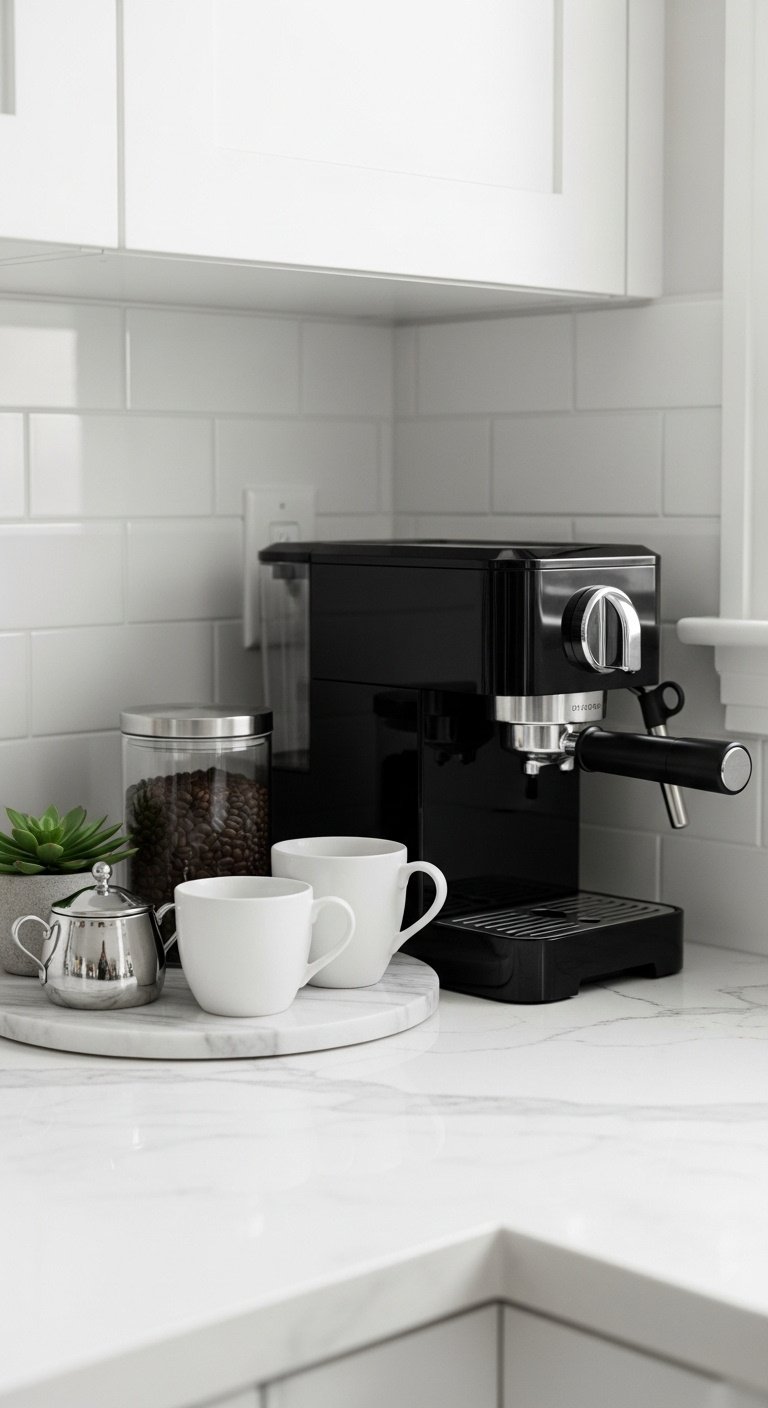
To set up a dedicated beverage station, you need to group all related items into one cohesive and accessible spot. This instantly turns a cluttered corner into a functional, café-inspired nook.
- Materials Needed: A decorative tray, your coffee maker/kettle, stylish canisters for coffee/tea/sugar, a mug tree or stackable mugs, a small container for spoons/stirrers.
- Step-by-Step Directions:
- Place your coffee maker or electric kettle diagonally into the corner to maximize space.
- Use a tray in front of the appliance to corral all the accessories. This creates a defined zone.
- Decant coffee grounds, beans, or tea bags into matching canisters for a cohesive look.
- Stack your favorite mugs or hang them on a small mug tree.
- Add a small plant or a tiny decorative sign to complete the look.
Pro Tip: Use a small, round tray or a lazy susan. The circular shape softens the harsh 90-degree angle of the corner and makes everything easily accessible with a simple spin.
Pin this cozy coffee station idea for your morning routine!
2. Style a Tiered Tray or Lazy Susan
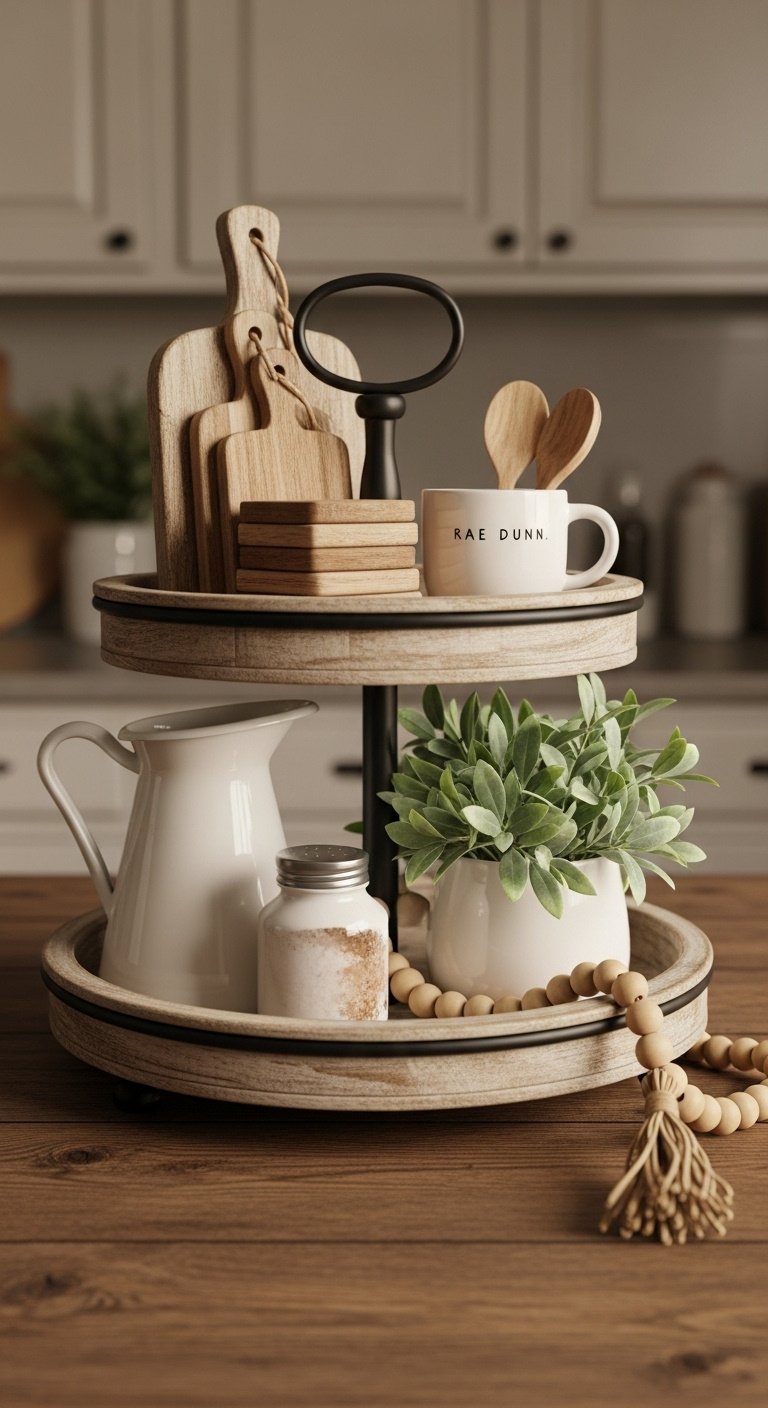
To effectively use a tiered tray or lazy susan, combine small decorative and functional items with varying heights. This creates a contained, organized display that adds vertical interest.
- Materials Needed: A 2 or 3-tier tray or a single-level lazy susan, a mix of small decorative and functional items of varying heights.
- Step-by-Step Directions:
- Choose a tray or lazy susan that complements your kitchen style (e.g., wood for farmhouse, metal for industrial).
- Place your largest item first, typically on the bottom tier, to act as an anchor. This could be a small potted plant or a candle.
- Add functional items you use daily, like a salt cellar and pepper grinder. Grouping them here clears up space elsewhere.
- Fill in the gaps with smaller, decorative pieces. Think about texture and height variation—drape a small string of wooden beads, add a mini rolling pin, or a small ceramic piece.
- Ensure the top tier has smaller, lighter items to maintain visual balance.
Lesson Learned: Don’t overcrowd it. The goal is “curated,” not “cluttered.” Leave some breathing room around each object to make the arrangement feel intentional and airy.
Save this farmhouse styling tip to your ‘Home Decor’ board!
3. Layer Cutting Boards & Artwork
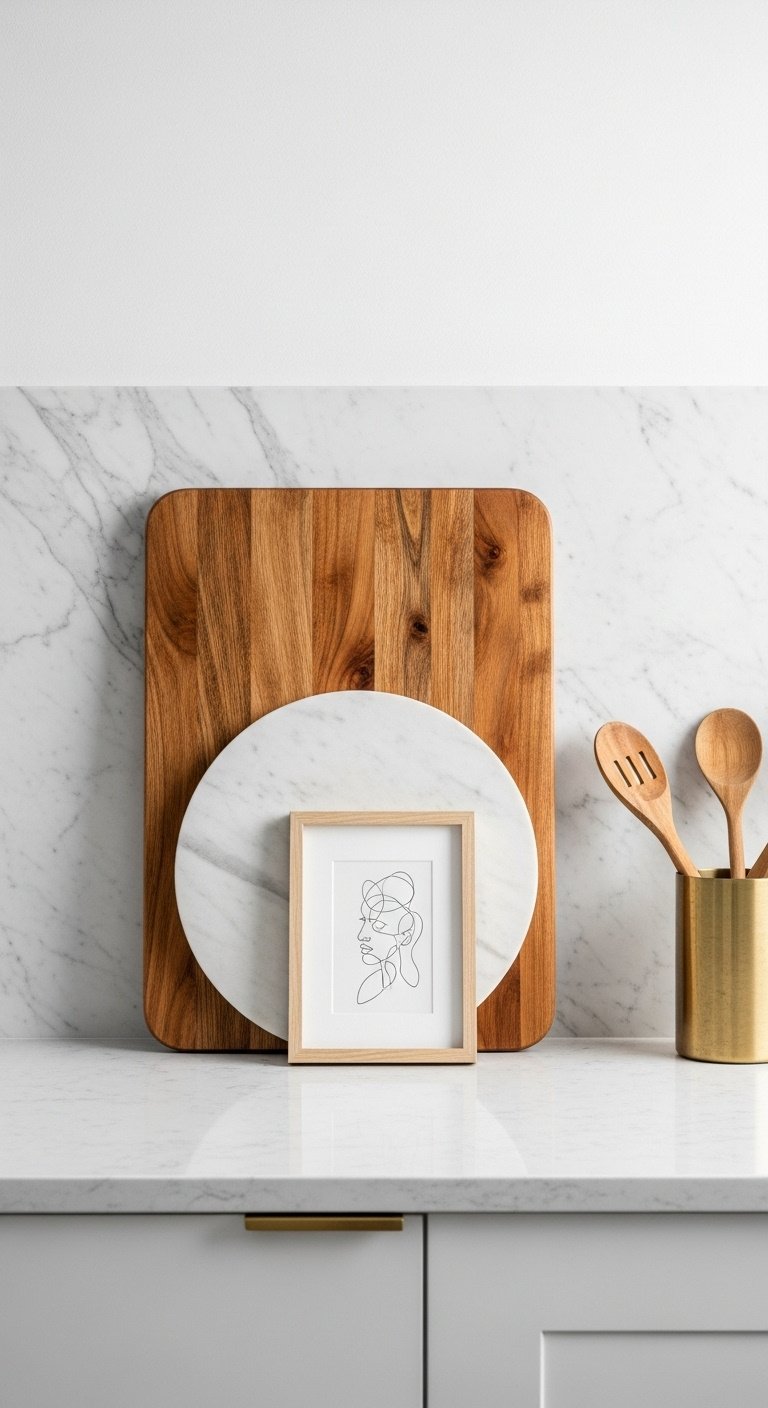
The design technique of layering involves leaning items of different sizes and textures against the backsplash. This adds instant depth, character, and visual interest to a flat corner.
- Materials Needed: 2-3 cutting boards of different sizes and materials (e.g., one large wood, one medium marble), one small piece of framed art or a cookbook on a stand.
- Step-by-Step Directions:
- Select the largest cutting board and lean it directly against the back corner of the backsplash. This will be your base layer.
- Choose a second, smaller cutting board of a contrasting material or shape. Lean it in front of the first one, slightly off-center.
- For the final layer, place a small, framed piece of art or an open cookbook on a stand in front of the cutting boards.
- This technique adds instant depth and is perfect for strategically hiding any unsightly wall outlets.
Pro Tip: Don’t be afraid to mix materials. The contrast between a warm, rustic wood board and a cool, sleek marble one creates a sophisticated, designer-level look with minimal effort.
Love this layering tips? Pin it for later!
4. Cultivate a Mini Herb Garden
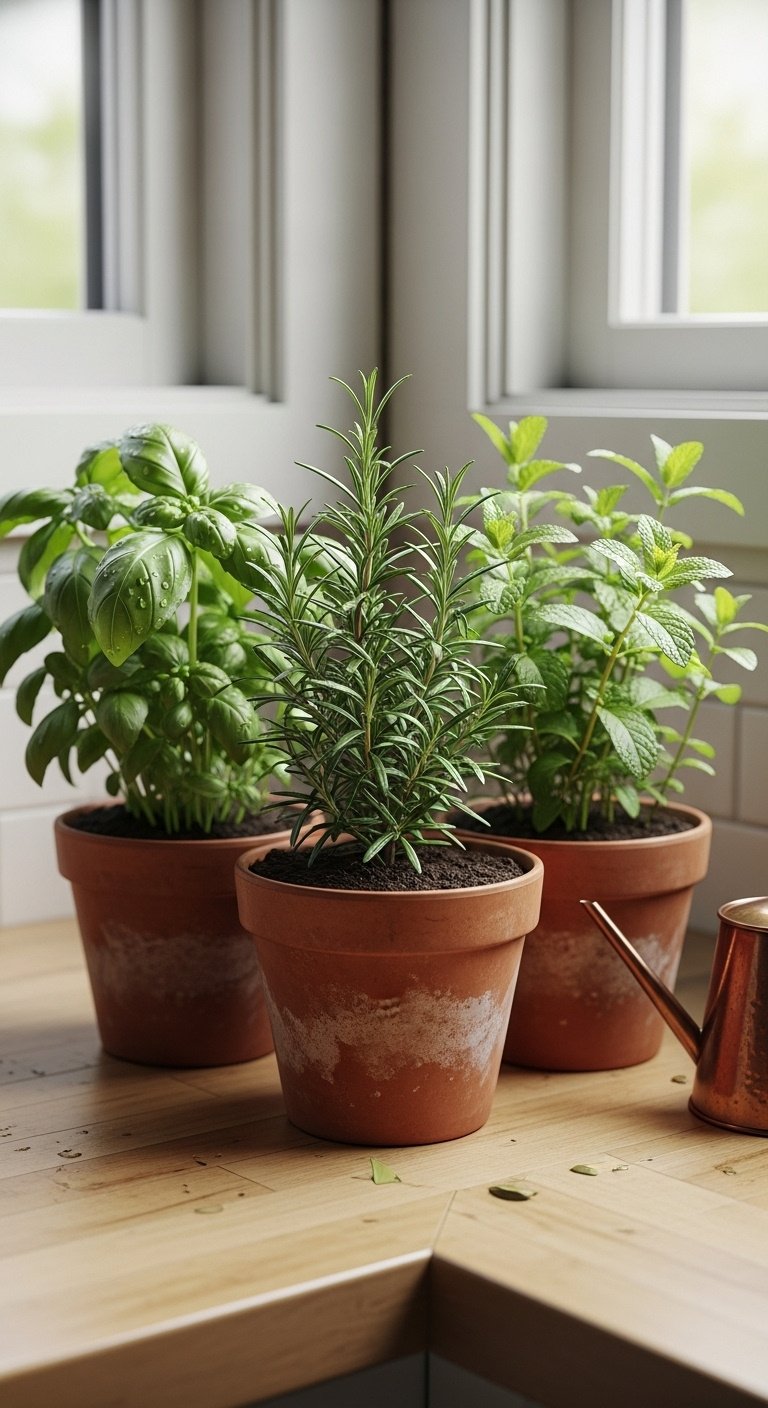
To create a mini herb garden, group several small pots of your favorite herbs together. This brings vibrant color, fresh scents, and culinary convenience right to your countertop.
- Materials Needed: 2-3 small pots or one long planter, potting soil, your favorite herb seedlings (basil, mint, and parsley are great starters), a small watering can.
- Step-by-Step Directions:
- Choose pots with drainage holes that fit comfortably in your corner space. Grouping three small pots often works better than one large one.
- Fill the pots with good-quality potting soil.
- Gently transfer your herb seedlings into the pots and water them lightly.
- Arrange the pots in the corner. If you have a window nearby, great! If not, the ambient light in most kitchens is enough for hardy herbs.
- Enjoy the fresh scent, vibrant green color, and the convenience of having fresh herbs on hand for cooking.
Pro Tip: Place your herb pots on a small tray or platter. This not only protects your countertops from water drips but also makes the collection look more cohesive and intentional.
Add a touch of green! Pin this herb garden idea.
5. Add Warmth with an Accent Lamp
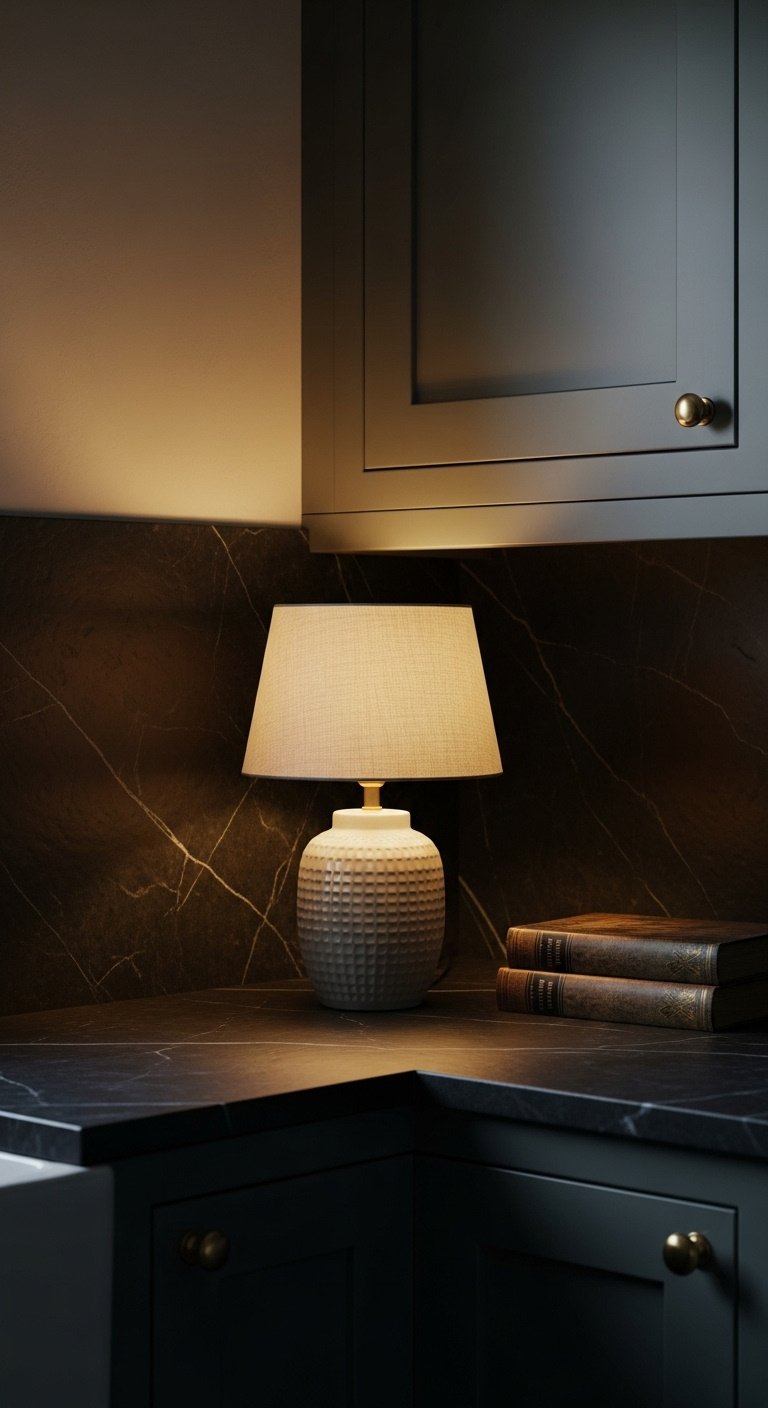
Adding warmth involves placing a small-scale lamp with a warm-white bulb in the corner. This simple addition eliminates dark shadows and creates a cozy, inviting ambiance.
- Materials Needed: One small-scale lamp with a slim profile, a warm-toned, low-wattage LED bulb.
- Step-by-Step Directions:
- Choose a lamp that is proportional to your space. A lamp with a small base won’t eat up valuable counter real estate.
- Look for a style that complements your kitchen—a ceramic base for a modern look, or a metal one for an industrial or farmhouse feel.
- Use a warm-white (2700K) LED bulb. This casts a soft, inviting glow rather than a harsh, clinical light.
- Place the lamp in the very back of the corner. It will wash the two walls with light, making the corner feel larger and eliminating dark shadows.
Lesson Learned: This is one of the most impactful changes you can make. Leaving just this small lamp on in the evening creates a beautiful, cozy ambiance that makes the entire kitchen feel more like a living space.
Brighten up your kitchen! Save this cozy lighting idea.
6. Display a Curated Collection of Vintage Finds
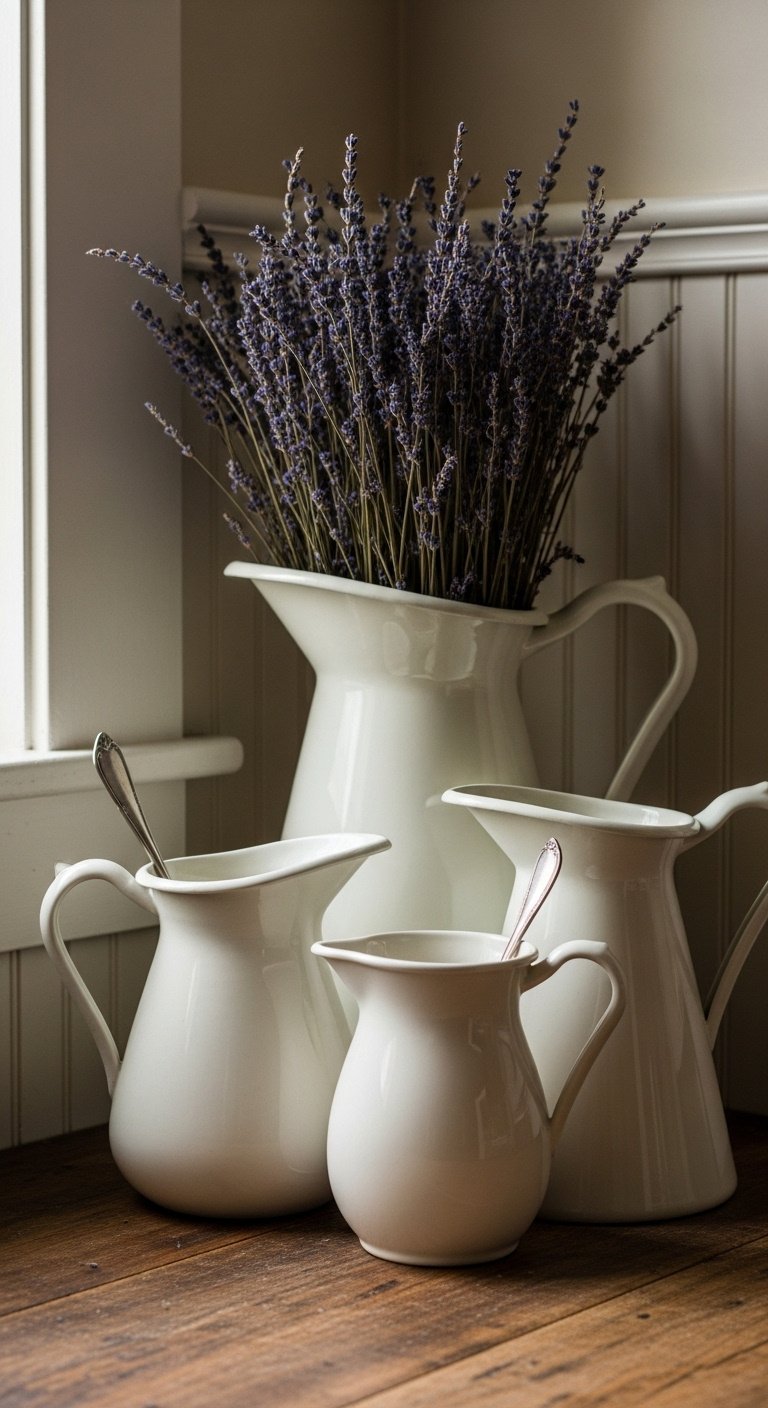
To display a collection, group 3-5 related vintage items with a common theme or color. This creates a personal vignette that adds immense character and tells a story.
- Materials Needed: A collection of 3-5 related items (e.g., small ironstone pitchers, antique wooden utensils, a set of vintage tea tins).
- Step-by-Step Directions:
- “Shop” your own home first for items that could work together. Look for a common theme, material, or color.
- Choose an odd number of items—3 or 5 usually looks best.
- Place the tallest item in the back corner.
- Arrange the other items in front, creating a triangular formation. For example, place a vintage crock in the back, and fill it with old wooden spoons. In front, place a smaller pitcher and a stack of small pinch bowls.
- This creates a personal vignette that tells a story and adds immense character.
Pro Tip: Stick to a tight color palette. A collection of all-white ironstone or all-wood pieces will look intentionally curated, while a random assortment of items can quickly look like clutter.
Add some character! Pin this vintage decor idea.
7. Install a Floating Corner Shelf

To utilize vertical space, install a floating shelf specifically designed for corners. This adds valuable storage and display area without taking up any counter real estate.
- Materials Needed: A corner floating shelf kit, a drill, a level, and decorative items to display.
- Step-by-Step Directions:
- Purchase a floating shelf specifically designed for corners to ensure a perfect fit.
- Following the manufacturer’s instructions, use a level to mark the placement on the wall. Ensure it’s high enough to not interfere with counter space but low enough to be a cohesive part of the decor.
- Securely install the shelf brackets and slide the shelf into place.
- Style the shelf with a mix of practical and decorative items. A stack of your most-used bowls, a couple of pretty cookbooks, and a trailing plant like a pothos is a classic, balanced combination.
Lesson Learned: This is the ultimate solution for small kitchens. It draws the eye upward, making the entire space feel larger, and it doubles your usable surface area in that corner without adding any clutter to the countertop itself.
Go vertical! Save this space-saving shelf idea.
Key Takeaways: Your Quick Guide to kitchen counter corner decor ideas
- Contain the Clutter: Use trays, lazy susans, or crocks to group small items into a single, organized unit.
- Prioritize Function: Choose decor that also serves a purpose, like a coffee station, herb garden, or a crock of utensils.
- Go Vertical: Add height and depth by layering cutting boards or installing a small corner shelf to draw the eye upward.
- Add Life & Light: Incorporate natural elements like plants or fruit and consider a small lamp to add a warm, cozy glow.
People Also Ask About kitchen counter corner decor ideas
How do you style an awkward kitchen corner?
Style an awkward kitchen corner by creating a defined “zone” with a tray to establish a base for a functional vignette like a coffee station. Add height by layering items like cutting boards against the backsplash, and incorporate a natural element like a small plant or a bowl of lemons to add color and life. The goal is to make the space look intentional and purposeful.
How can I decorate my kitchen counters without them looking cluttered?
The key to clutter-free counter decor is containment and choosing functional pieces. Group smaller items (like salt, pepper, and oil) on a decorative tray. Instead of purely ornamental objects, upgrade everyday essentials like your soap dispenser or utensil crock. Finally, adhere to the “less is more” principle—a few well-chosen items will always look better than many small ones.
What is the newest trend in kitchen counter tops for 2025?
For 2025, the trend continues to move towards durable, natural, and nature-inspired materials like quartz. Quartz remains highly popular for its low maintenance and vast design options, often mimicking the look of marble. Additionally, countertops with bold, dramatic veining and warmer, earthy tones like beige and greige are gaining traction over stark whites, creating a cozier, more organic feel in the kitchen.
Final Thoughts
That once-awkward kitchen corner no longer has to be a source of frustration. Think of it as your kitchen’s best-kept secret—a fantastic opportunity to inject personality, beauty, and smart function into the heart of your home. By choosing one of these simple yet impactful ideas, you can transform that forgotten space into a stylish corner you truly love.
Which of these ideas are you excited to try in your kitchen corner? Let me know in the comments below
